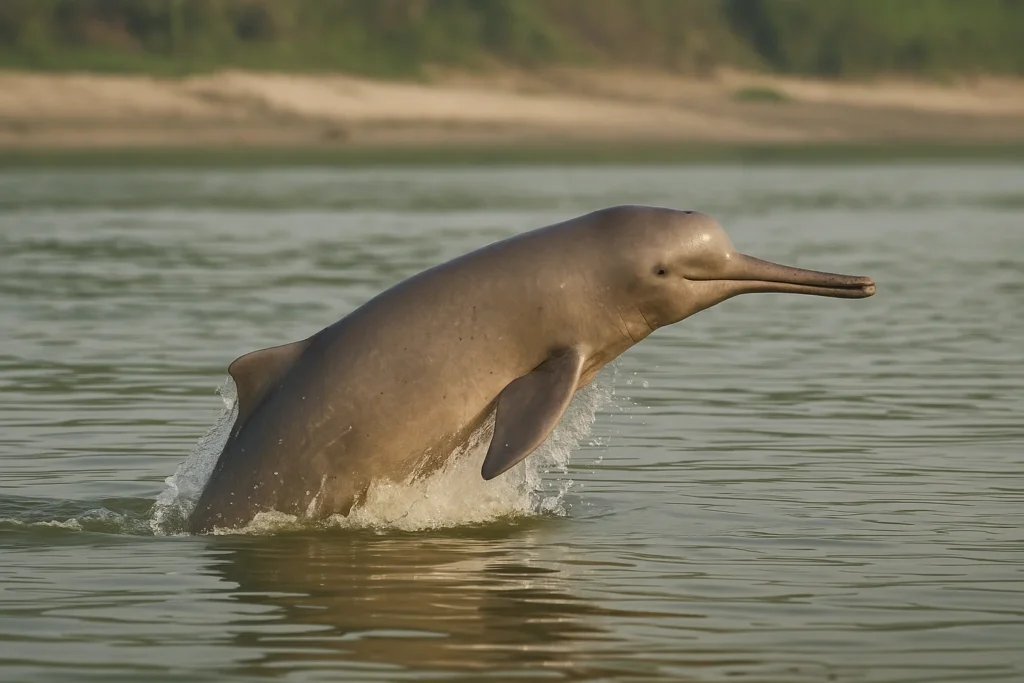The Last Breath of the Susu: A Whisper from Ancient Waters
Imagine a creature born of the mists of time, a living echo of an era long past. For 20 million years, through epochs of ice and fire, through the rise and fall of civilizations, the Gangetic dolphin, affectionately known as “Susu,” has navigated the serpentine embrace of India’s sacred rivers. Its soft, distinctive “susu” sound, the breath taken as it momentarily breaks the surface in the pre-dawn stillness of the Ganges, is a haunting melody from a forgotten world. These ancient navigators, scientifically known as Platanista gangetica, are more than just a species; they are sentient threads in the rich tapestry of India’s natural and cultural heritage, their very existence intertwined with the health and vitality of the mighty Ganga. Yet, today, these extraordinary beings, blind to the world around them but acutely attuned to the river’s vibrations, face their most formidable adversary: humanity itself.
A River Ghost Fading Away: The Silence of Shrinking Realms
Once, the Susu’s numbers were a testament to the Ganga’s abundance, their playful leaps a common sight. Legends whispered of tens of thousands gracing the river’s expanse. But the whispers have grown faint, replaced by the somber reality of vanishing populations. Recent surveys paint a grim picture: a mere 2,500 to 3,000 Gangetic dolphins are believed to remain in India’s rivers. Their sightless eyes, which evolved without lenses in the perpetually muddy waters, have witnessed an alarming decline in their world. The story told by the numbers is stark:
- A staggering 80% population decline has occurred in just the last 50 years, a rapid descent into the abyss of extinction.
- Once vibrant in numerous tributaries, the Susu is now extinct in many of these historical habitats, their absence a silent testament to human impact.
- Tragically, only 5 viable populations cling to survival within the entire vast Ganga-Brahmaputra river system, isolated pockets struggling against overwhelming odds.
Dr. Rajiv Sinha, a revered figure in India’s dolphin conservation efforts, recounts with a palpable sense of loss, “When I began studying them in the 1980s, observing 30 dolphins in a single morning near Patna was not uncommon. Today, finding even five is considered a significant achievement, a small victory against the tide of their disappearance.” His words underscore the profound shift, a stark contrast between a thriving past and a precarious present.
The Many Deaths of the Susu: A Symphony of Threats
The decline of the Gangetic dolphin is not the result of a single catastrophic event, but rather a slow, agonizing demise orchestrated by a multitude of human interventions. Each factor acts as a contributing antagonist in this tragic saga, pushing the Susu closer to the brink.
1. The Concrete Strangulation: A River Divided
The lifeblood of the Susu, the Ganga, has been transformed from a free-flowing, dynamic ecosystem into a series of disconnected pools, its natural rhythms disrupted by an ever-increasing network of dams and barrages. Over 400 major barriers now fragment its majestic flow, each structure a literal chokehold on the river’s natural pulse.
Consider the Farakka Barrage, a colossal structure that severed the dolphins’ ancient migration routes to Bangladesh, effectively marooning populations. The towering Tehri Dam, while generating power, fundamentally altered the river’s temperature and flow regimes downstream, creating an alien environment for these sensitive creatures. Further upstream, the Bijnor Barrage birthed a 165 km “dead zone,” an ecological void where the river’s vitality has been extinguished.
Each of these man-made structures acts like a tightening noose, isolating dolphin populations into genetic bottlenecks. A sobering 2022 study revealed that dolphins trapped above these barrages exhibit a shocking 40% lower genetic diversity. This reduced genetic pool is not just a scientific statistic; it’s a death sentence in waiting, severely compromising their ability to adapt to environmental changes and resist disease, thereby imperiling their long-term survival.
2. The Chemical Soup: A Toxic Legacy
The Ganga, revered as a sacred mother, now carries a heavy burden of human waste, transforming its waters into a treacherous chemical soup. At Varanasi’s historic ghats, where countless devotees seek spiritual solace daily, the water holds a hidden menace. Analysis reveals alarming concentrations of pollutants:
- Mercury levels 26 times higher than safe limits, a chilling legacy from thermometer factories and other industrial discharges.
- Lead concentrations that rival the most toxic industrial effluents, poisoning the very essence of the river.
- Pesticide loads that, while perhaps invisible to the naked eye, accumulate insidiously in the delicate blubber of the dolphins, turning their bodies into ticking time bombs.
Dr. Sunil Kumar, a forensic toxicologist specializing in marine life, observes grimly, “Their bodies are chemical time bombs.” His autopsies of deceased dolphins reveal that they now carry twice the toxin load compared to those from the 1990s. Every breath, every hunt, every moment spent in these contaminated waters contributes to a slow, agonizing poisoning, leading to weakened immune systems, reproductive failures, and ultimately, premature death.
3. The Silent Killer: An Underwater Cacophony
For the Gangetic dolphin, whose sightless eyes are compensated by an extraordinary sense of echolocation, sound is life. Their world is a symphony of clicks, whistles, and echoes, allowing them to navigate, hunt, and communicate in the murky depths. But the modern Ganga has become an unbearable cacophony, a relentless assault on their auditory world.
The incessant roar of boat engines, particularly those of illegal sand dredgers, creates a pervasive underwater hum that masks the dolphins’ crucial echolocation clicks, rendering them effectively blind and disoriented. The constant rumbling of sand dredgers tears through the silence, making it impossible for them to discern their prey or sense approaching dangers. Even the rhythmic thud of construction pile-driving along the riverbanks sends shockwaves through the water, causing temporary deafness and profound distress.
Researchers at IIT Kanpur have quantified this auditory assault, discovering that dolphins inhabiting areas near urban centers experience 42% fewer successful hunts due to the overwhelming noise interference. This isn’t just an inconvenience; it’s a direct threat to their survival, forcing them to expend more energy to find food in an already challenging environment.
The Turning Tide: India’s Conservation Revolution
Despite the daunting challenges, a quiet revolution is stirring along the banks of the Ganga. India, recognizing the irreplaceable value of the Susu, has begun to mobilize its resources and its people in an unprecedented conservation effort, demonstrating a powerful commitment to safeguarding its natural heritage.
1. Operation Gangetic Shield (2023): A Beacon of Hope
Launched in 2023, Operation Gangetic Shield stands as the largest river conservation initiative in India’s history, a bold declaration of intent to protect the Susu and its habitat.
- Over 1,200 km of the river have been officially designated as “Dolphin Priority Zones,” areas where conservation efforts are intensified and protective measures strictly enforced.
- Dedicated night patrolling teams have been deployed to combat the rampant illegal sand mining, a destructive activity that not only degrades habitat but also contributes to the alarming noise pollution.
- Cutting-edge satellite tagging technology has been employed, with 120 dolphins now providing real-time tracking data, allowing scientists to monitor their movements, identify critical habitats, and respond swiftly to threats.
Early results from this ambitious undertaking are incredibly promising, with an observed 17% population increase in the protected stretches of the river. This tangible success offers a glimmer of hope, proving that focused, collective action can indeed turn the tide.
2. The Fishermen’s Pact: Guardians from the Community
In Bihar’s Mokama Tal, an area once tragically known as a dolphin graveyard due to destructive fishing practices, a remarkable transformation has taken place, forged by understanding and shared vision.
- A powerful alliance was formed, with 5,000 fishermen voluntarily embracing dolphin-safe fishing nets, a testament to their commitment to coexisting with these magnificent creatures.
- Community-led guards now diligently remove approximately 15 tons of lethal “ghost nets” (discarded fishing gear that continues to entrap and kill marine life) from the river annually, a heroic effort that directly saves countless dolphins.
- This shift has also ushered in a new era of sustainable livelihood, with eco-tourism now providing a significant 30% of local income. Fishermen who once inadvertently harmed dolphins are now their proud protectors and passionate guides.
Sarju Prasad, a man who once engaged in poaching but now leads eco-tours, articulates this profound shift with heartfelt simplicity: “Now when I see a dolphin, I see my children’s future.” His words encapsulate the essence of this community-driven success story: conservation as an investment in a shared, prosperous future.
3. The Dolphin Army: Igniting Young Hearts
The future of the Ganga and its unique inhabitants lies in the hands of the next generation. Recognizing this, an innovative program has been launched across 200 riverside schools, nurturing a “Dolphin Army” of young conservationists.
- The “Junior River Wardens” program trains children in the fundamentals of conservation, transforming them into active stewards of their local environment.
- Engaging dolphin mascots bring science to life, making learning about river ecology and conservation both fun and impactful.
- Equipped with simple water testing kits, students become citizen scientists, actively monitoring local pollution levels and understanding the direct impact of human activities on river health.
In Allahabad, the passionate protests of these young environmentalists directly led to the closure of three polluting tanneries, demonstrating the potent power of informed, collective action, even from the youngest members of society.
The Road Ahead: Challenges & Enduring Hope
While the turning tide offers optimism, the journey to secure the Susu’s future is far from over. Significant challenges loom, but so too do innovative solutions and an unwavering spirit of determination.
The Dam Dilemma: Balancing Progress with Preservation
The push for new infrastructure, like the proposed Pancheshwar project, continues to threaten vital dolphin habitat. However, a new paradigm is emerging, one that seeks to integrate conservation into development:
- Dolphin ladders, ingenious modifications of traditional fish ladders, are being explored to allow dolphins safe passage around large dams, reconnecting fragmented populations.
- E-flow regulations are being rigorously implemented, ensuring that minimum water releases from dams mimic natural flow patterns, maintaining critical habitats downstream.
- Cutting-edge bubble curtains are being trialed, using compressed air to create underwater barriers that gently guide dolphins away from dangerous turbine intakes, protecting them from harm.
The Plastic Plague: A Choking Threat
The pervasive threat of plastic pollution casts a long shadow over the Ganga. Disturbingly, an average of 47 plastic pieces have been found in the stomach of every dolphin examined, a horrifying testament to the sheer volume of debris choking the river. Innovative solutions are desperately needed and are now in trial:
- Riverine plastic harvesters, inspired by successful Dutch designs, are being deployed to systematically collect plastic waste before it breaks down into microplastics and enters the food chain.
- The burgeoning field of mycoremediation is being explored, harnessing the power of plastic-eating fungi to naturally break down persistent plastic pollutants.
- Bottle deposit schemes are being piloted in riverside towns, incentivizing proper disposal and encouraging recycling, fostering a circular economy that keeps plastic out of the river.
The Climate Crisis: Adapting to a Changing River
The looming shadow of climate change presents perhaps the most existential threat. With Himalayan glaciers retreating at an alarming rate, the Ganga’s flow could plummet by an estimated 30% by 2050, drastically altering its ecosystem. Adaptation strategies are being developed with urgency:
- The creation of artificial oxbow lakes is being considered as potential drought refuges, providing vital sanctuaries for dolphins and other aquatic life during periods of low water.
- Shade nets are being tested over critical pools to mitigate rising water temperatures, ensuring conditions remain suitable for temperature-sensitive species.
- Innovative monsoon water banking in upstream aquifers is being explored, a strategy to store excess monsoon rainfall for release during drier periods, maintaining a more consistent flow.
Why This Fight Matters: More Than Just a Dolphin
The Susu is far more than just another animal on the brink. It is a profound symbol, a critical indicator, and an economic asset all rolled into one.
- A Barometer of River Health: The Susu acts as an ecosystem engineer, its health directly reflecting the overall vitality of the river. A thriving dolphin population indicates a healthy food web, clean water, and a balanced ecosystem. Conversely, their decline signals a gravely sick river, impacting not just aquatic life but also the 500 million people who depend on the Ganga for their sustenance and spiritual well-being.
- A Cultural Icon: From ancient Mauryan coins to intricate Mughal miniatures, the Gangetic dolphin has been woven into the fabric of India’s culture and folklore for millennia. It is a living legend, an embodiment of the river’s mystical power and enduring spirit. Its loss would be an irreparable blow to India’s cultural identity.
- A Biological Marvel: With their unique adaptations, including their reliance on echolocation in perpetually murky waters, these creatures are biological marvels, offering invaluable insights into evolution and sensory biology. Their existence enriches the planet’s biodiversity in profound ways.
- A Tourism Magnet: The allure of spotting these enigmatic creatures has transformed them into significant tourism magnets, generating an estimated $12 million annually through eco-tourism initiatives. This provides sustainable livelihoods for riverside communities and fosters a direct economic incentive for conservation.
As the renowned conservationist Sunita Narain eloquently states, “Saving the dolphin isn’t charity – it’s self-preservation for 500 million Indians.” The fate of the Susu and the fate of the Ganga are inextricably linked to the fate of the people who call its banks home.
How You Can Be Part of the Solution: Empowering Every Hand
The battle for the Susu’s survival is a collective endeavor, requiring the dedication of scientists, government agencies, local communities, and individuals alike. Your actions, no matter how small, can contribute to this grand narrative of recovery.
- Reduce Your Chemical Footprint: Every household choice has an impact.
- Switch to organic and biodegradable detergents to prevent harmful chemicals from entering the waterways.
- Properly dispose of medicines at designated collection points, rather than flushing them down the drain.
- Minimize the use of chemical fertilizers and pesticides in your gardens, as these often leach into rivers and groundwater.
- Become a Citizen Scientist: Lend your eyes and ears to the cause.
- Join the Dolphin Spotter app network, reporting your sightings to contribute valuable data to conservation efforts.
- Organize or participate in river cleanups in your local area, directly removing harmful waste.
- Use simple water quality testing kits to monitor local pollution levels and report anomalies to authorities.
- Vote With Your Wallet: Support businesses that prioritize sustainability.
- Choose dolphin-friendly fisheries that employ sustainable fishing practices and avoid destructive methods.
- Opt for responsible tourism operators who adhere to ethical guidelines and contribute to local conservation initiatives.
- Consider investing in clean Ganga bonds or supporting NGOs actively working on river rejuvenation.
- Spread the Word: Knowledge is power.
- Share dolphin documentaries and educational videos with your friends and family to raise awareness.
- Organize community screenings of conservation films and discussions to ignite local action.
- Teach children about river folklore and the importance of the Susu, fostering a sense of connection and responsibility from a young age.
Epilogue: The Susu’s Song Continues, A Symphony of Hope
On a crisp winter morning near Sahibganj, amidst the soft, swirling mists, researchers recently bore witness to an extraordinary sight – a dolphin calf, no more than a few months old, engaging in playful leaps and dives in waters that, just five years prior, had been tragically declared “dead.” Its joyful exuberance, its uninhibited frolic, mirrored the profound sense of hope now surging across the entire Ganga basin.
The battle to save the Gangetic dolphin is undeniably far from won. The river, and its ancient inhabitants, still face immense pressures from development, pollution, and climate change. Yet, the tide is undeniably turning. The combined efforts of dedicated scientists, empowered communities, and a growing public awareness are beginning to yield tangible results. With continued vigilance, unwavering commitment, and a deep reverence for this sacred creature, the haunting, life-affirming breath of the Susu may yet echo through the vast expanse of India’s rivers for millennia to come – a living, breathing testament to humanity’s capacity to correct its course, to heal its wounds, and to truly value what it stands to lose.
What do you think is the single most important action an individual can take to support the survival of the Gangetic dolphin?




9gy2ks